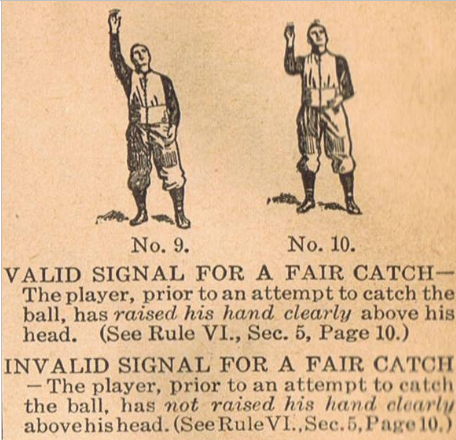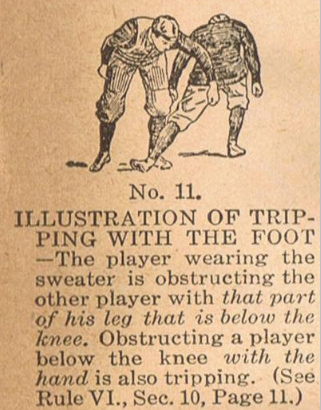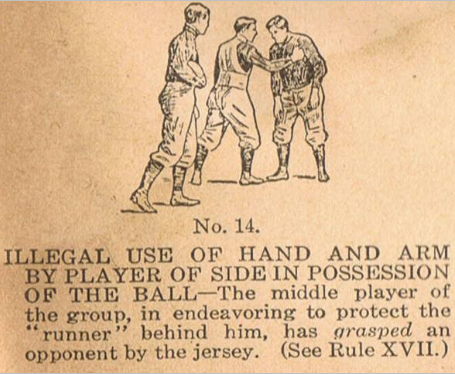In this episode of the Football's History Rewind we discuss the reules revisions of 1921 regarding punting, holding, and fair catches and their impact on today's game as well as many more Legendary stories.
Football History Rewind Part 48
Fair Catch Holding and more
The type of football that took place over 100 years ago is very interesting for the person of the era to look back upon and to see just how far the game has come since the 1920's. Then again there are some items perused in the 1921 - Spalding’s Official Foot Ball Guide that are worded almost to the letter with a corresponding rule in the twenty-first century. The Football Rules definitely fit into the old adage, “the more things change the more they stay the same.”
The last segment of this series gave a very interesting perspective into the rule of the 1921 season as sketches of legal and illegal plays from the Spalding’s Guide were posted with the permission of the NCAA and discussed. This edition of Fathers will continue the discussion and present even more of the 86 year old hand sketches to the reader.
The Fair Catch
Figures “No. 9 & No. 10" are the do’s and don’ts of the fair catch signal in 1921. It is one of those rules and signals that has survived the test of time. The 1921 version of the fair catch signal has the key elements of “prior to an attempted catch” and then “ the hand clearly above the players head” just as Figure No. 9 shows. The corresponding recent NFHS Rule (2-9-3) reads very similar to its ancient predecessor:

“A valid fair-catch signal is the extending and lateral waiving of one arm, at full arm’s length above the head, by any member of the receiving team.”
The similarities of the rules are many although in modern times the arm must be waived. Figure No. 10 shows an example of an invalid signal in 1921 and this same signal if used today would also be considered invalid (Rule 2-9-4a). Another difference in the rules is that in today's game any player on the receiving team can signal for fair catch while in 1921 only the obvious player trying to attempt the catch could do so legally.
Tripping

The figure labeled No. 11 from the 1921 Guide demonstrates what was considered a trip in that day. According to the 1921 rules it was illegal for an opponent to obstruct a player with leg, hand or arm below his knee. A trip back then basically is still the same today as the recent NFHS Rule 2-45 states;
“Tripping is the use of the lower leg or foot to obstruct an opponent, who is not the runner below the knee.”
The new version does not call the use of the hand below the knee to obstruct an opponent without the ball a “trip” but has since reclassified this illegal act as a “hold” or even may be an illegal block below the waist.
As a side note to Figure No. 11 it is interesting to see the description “The player wearing the sweater...” in reference to pointing out a particular player in the sketch.
Figure Number 12 - the legal block?
This next illustrated example from antiquity is interesting indeed when compared to the modern NFHS rules. Figure No. 12 clearly shows and states that the offensive player is initiating contact on the opponent’s thigh. By today’s standards this is mainly an illegal starting point for a block except in certain cases.

The NFHS ‘s version of the free blocking zone allows players who are clearly on their team’s line at the snap and within the defined boundaries of the free blocking zone (6 yard x 8 yard box centered around the ball) may block below the waist on an opponent who is also clearly in the boundaries of the FBZ at the snap on the initial charge after the snap. Other than this instance there are few instances where a player of A can initiate contact below an opponent’s waist such as the thigh.
Hold
The final illustration of this segment labeled No.14 describes an example of illegal use of hand and arm by a player in 1921. The middle player depicted in the sketch is “grasping” the jersey (this same garment was a “sweater” earlier) of an opponent in an effort to obstruct him from getting to the runner. According to the enforcement of that era this action would penalize the offending team fifteen yards for the illegal action. A hold in the modern NFHS governed games though carrying a slightly lesser penalty than in 1921 would be just as illegal none-the-less.

It is evident in all of the illustrations presented in this segment and in the one prior that the basics of football rules were in place nine decades ago. The strategies, equipment and overall appearance of the game may have changed over time but the basic fundamentals of legality have remained fairly constant.
Credits
The picture in the banner above is courtesy of the NCAA and the 1921 Spaldings Official Foot Ball Rules Book. We can learn so much about football when we look at its past!






